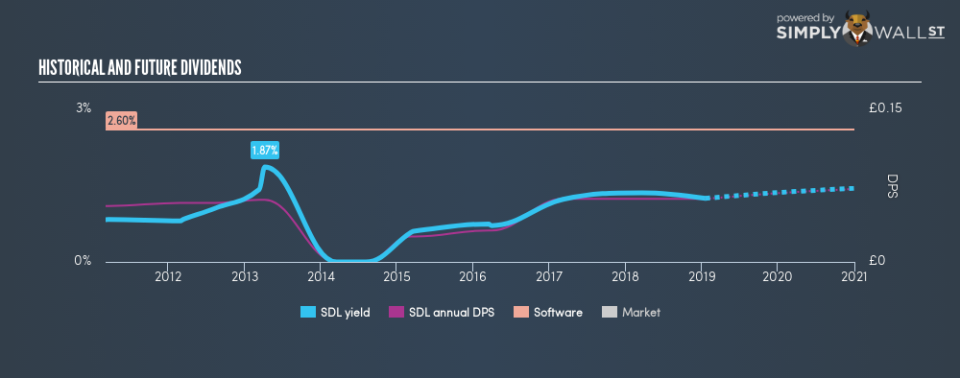Is SDL plc (LON:SDL) An Attractive Dividend Stock?

Dividends play an important role in compounding returns in the long run and end up forming a sizeable part of investment returns. Historically, SDL plc (LON:SDL) has paid dividends to shareholders, and these days it yields 1.3%. Does SDL tick all the boxes of a great dividend stock? Below, I’ll take you through my analysis.
See our latest analysis for SDL
Want to help shape the future of investing tools and platforms? Take the survey and be part of one of the most advanced studies of stock market investors to date.
Here’s how I find good dividend stocks
If you are a dividend investor, you should always assess these five key metrics:
Is it paying an annual yield above 75% of dividend payers?
Has it paid dividend every year without dramatically reducing payout in the past?
Has dividend per share risen in the past couple of years?
Can it afford to pay the current rate of dividends from its earnings?
Will it have the ability to keep paying its dividends going forward?
How does SDL fare?
The company currently pays out 33% of its earnings as a dividend, according to its trailing twelve-month data, meaning the dividend is sufficiently covered by earnings. In the near future, analysts are predicting lower payout ratio of 23% which, assuming the share price stays the same, leads to a dividend yield of around 1.4%. However, EPS should increase to £0.20, meaning that the lower payout ratio does not necessarily implicate a lower dividend payment.
When considering the sustainability of dividends, it is also worth checking the cash flow of a company. Companies with strong cash flow can sustain a higher payout ratio, while companies with weaker cash flow generally cannot.
If there is one thing that you want to be reliable in your life, it’s dividend stocks and their constant income stream. The reality is that it is too early to consider SDL as a dividend investment. It has only been consistently paying dividends for 8 years, however, standard practice for reliable payers is to look for a 10-year minimum track record.
Relative to peers, SDL produces a yield of 1.3%, which is on the low-side for Software stocks.
Next Steps:
After digging a little deeper into SDL’s yield, it’s easy to see why you should be cautious investing in the company just for the dividend. On the other hand, if you are not strictly just a dividend investor, the stock could still be offering some interesting investment opportunities. Given that this is purely a dividend analysis, I recommend taking sufficient time to understand its core business and determine whether the company and its investment properties suit your overall goals. Below, I’ve compiled three important aspects you should look at:
Future Outlook: What are well-informed industry analysts predicting for SDL’s future growth? Take a look at our free research report of analyst consensus for SDL’s outlook.
Valuation: What is SDL worth today? Even if the stock is a cash cow, it’s not worth an infinite price. The intrinsic value infographic in our free research report helps visualize whether SDL is currently mispriced by the market.
Dividend Rockstars: Are there better dividend payers with stronger fundamentals out there? Check out our free list of these great stocks here.
To help readers see past the short term volatility of the financial market, we aim to bring you a long-term focused research analysis purely driven by fundamental data. Note that our analysis does not factor in the latest price-sensitive company announcements.
The author is an independent contributor and at the time of publication had no position in the stocks mentioned. For errors that warrant correction please contact the editor at editorial-team@simplywallst.com.

 Yahoo Finance
Yahoo Finance 
